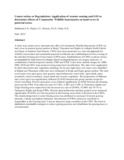| dc.description.abstract | A study was carried out to determine the effect of Community Wildlife Sanctuaries (CWS) on land cover in pastoral group ranches in Koija, Tiemamut and Kijabe in Laikipia North District and Girgir in Samburu East District. CWSs have been promoted as a win-win approach for wildlife conservation and sustainable pastoral livelihoods and establishment involves zoning of the land into Grazing and Conservation (CWS) areas. Establishment of CWSs is almost always accompanied by land use/cover change whose ecological impacts are largely unknown. A combination of multi-temporal Landsat (TM5 and ETM 7) and Aster satellite images for 2000, 2005, 2010 and 2011 were analysed using supervised classification. The latter were augmented by field observation and vegetation sampling. Seven and eight land cover types were identified in Kijabe and Tiemamut while nine were delineated in Koija and Girgir group ranches. The land cover types were open grass, bare ground, open herbaceous, water body, open shrub, open woodland, closed woodland, closed shrub and riverine vegetation. The proportions of different land cover types was significantly different (P<0.05) between the group ranches except for closed woodland. Percent open grass cover differed significantly (p<0.05) between the Grazing areas and the CWS. It declined at a rate of 5.92%, 2.20% and 5.18% in Tiemamut, Kijabe and Girgir Grazing areas respectively but increased at a rate of 20.96%, 52.96% and 19.7% in Tiemamut, Kijabe and Koija CWSs. Percent open herbaceous and bare ground cover increased significantly (P<0.05) over the ten period in the Grazing areas while it declined in the CWSs. The deteriorating trend in some Grazing areas was attributed to increased livestock grazing intensity, climate and human utilization. Introduction of CWSs seemed to contribute to degradation in the Grazing areas
2
and an improved range condition in the CWS. The need to implement sustainabl | en |

